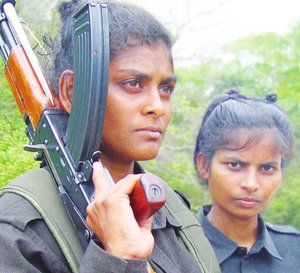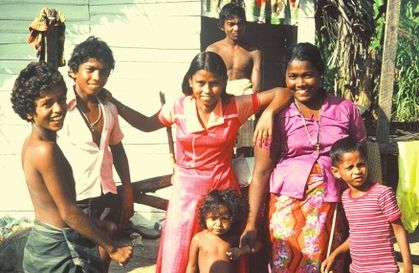
Publisher:
Bonnie King
CONTACT:
Newsroom@Salem-news.com
Advertising:
Adsales@Salem-news.com

~Truth~
~Justice~
~Peace~
TJP
Oct-10-2012 13:54

 TweetFollow @OregonNews
TweetFollow @OregonNews
My Daughter, The Terrorist
Laura Hughes Special to Salem-News.com“It’s better that my daughter dies with a gun in her hand than is killed or raped”
 Female Tamil Tigers in Sri Lanka |
(NEW YORK NOUSE) - Destroyed women or monstrous and crazed terrorists? For Beate Arnstead these suicide bombers are victims of war. Women from the Liberation Tigers of Tamil Eelam (LTTE) fought since the 1970s for an independent Tamil state. In Sri Lanka’s devastating civil war, these rebel women were prepared to sacrifice their lives as suicide bombers. Despite CNN and the BBC’s failed attempts to access these “crazy women”, Beate was determined to find the women behind the bombs.
Beate Arnstead is the director of the documentary My Daughter the Terrorist, which led the first foreign film crew into the guerrilla territory of Sri Lanka’s Tamil Tigers. My Daughter the Terrorist won the award for Best International Feature-length Documentary in 2007 and secured Beate a place on Sri Lanka’s blacklist. Beate had provided a platform for the condemned voices of female suicide bombers. The documentary called for an international audience to bear witness to one of the most professional guerrilla organisations in the world.
Beate currently serves on the advisory panel of the charity ‘Sri Lanka Campaign for Peace and Justice,’ a global non-partisan movement appealing for an end to human rights abuses in Sri Lanka, the repeal of anti-terror regulations, and a credible war crimes enquiry. In April 2011, the United Nations alleged that both the LTTE and Sri Lankan Government committed vast atrocities during the war. The Government denounced the report as biased, and in March 2012, the UN Human Rights Council, was forced to adopt a resolution urging Sri Lanka to investigate war crimes, which Sri Lanka claims usurps the country’s sovereignty. The charity also seeks to protect the rights of Sri Lanka’s journalists. Since 2005, 34 journalists have been murdered, yet not a single murderer has been sent to prison, and up to 25 journalists a year are fleeing the country. The war in Sri Lanka is not over and journalists are still fighting.
“It’s better that my daughter dies with a gun in her hand than is killed or raped”
Journalists are forced to write under pseudonyms, regularly receive threats and knowingly sacrifice their lives for a story. Sri Lanka is a country with a history of contested identities, and it is not political apathy, but terror, that secures Mahinda Rajapaksa his de facto dictatorship. As a journalist, if you cross the line you risk never getting back behind it. An editor’s loyalty to their staff and conscience makes criticism a complex and delicate balancing act. Even if Sri Lankans accept that the political system is in disarray – the risk of abduction and abuse often outweighs the merits of telling a story that doesn’t want to be heard. Journalists continue to risk their lives smuggling information to the UN, aid agencies or the international press. Uncomfortable questions put journalists’ lives in uncomfortable positions.
On this tropical island of serendipity, during Sri Lanka’s twenty-six year civil war, more than 70,000 lives were lost and hundreds of thousands displaced. The LTTE are a militant organisation, who fought the government for an independent Tamil state. The war was brought to an end in May 2009 when the Sri Lankan army defeated the Tamil Tigers. Among the uniformed soldiers of the Tamil Tigers are the Black Tigers, an elite platoon of suicide bombers. Beate’s documentary tells the story of two female Black Tigers, twenty-four year old girls, Dharsika and Puhalchudar. Women prepared to tie mines to their chests and sacrifice their stories for a cause.
“I became interested in what kind of women were volunteering for such missions and found little research.” When trying to find out, she was repeatedly told “that these destroyed women were just mad and dangerous.” I asked if Beate had been able to feel maternal towards girls the world were condemning as terrorists. “I spoke to lots of women, many of whom didn’t have any alternative. Their parents were in refugee camps, they were displaced, starved or sick and they didn’t have anything. These women have seen nothing but war.” When watching the documentary it is hard to remove yourself from the courage of these culprits of terror. It is difficult to remember that these girls have committed monstrous acts of murder. The girls’ laughter drowns their rifles stuttering, and their tears are wiped away by smiles, as they tell Beate of their terrible stories.
Beate Arnstead told me she was looking to make a film we wouldn’t normally see. No one had previously accessed Sri Lanka’s Northern war zone and Beate explained she had found very little understanding of the Tigers besides documentation of their crimes. Some of the LTTE’s most infamous crimes include the death of President Premadasa and the murder of Indian premier Rajiv Gandhi. Beate explained that her “Norwegian nationality and the temporary ceasefire made it possible to go to areas in the North held by the LTTE.” Norway has placed a central role in peace negotiations and in 2000, the Sri Lankan government and LTTE, had invited Norway to take the role of facilitator in the peace process. “The Tigers favoured Norwegians at that time.”
“I started just travelling to war-affected areas. When you live in Colombo you see the war with different eyes than you see it from the LTTE controlled areas of the island. I was amazed that the world interpreted the war through these eyes of the officials in Sri Lanka. When I finally went up there it was not that difficult to see the war through Tamil eyes.” Beate admitted the trips were a revelation and that she had found a completely different angle to the conflict. “I didn’t want to talk to any politicians or hear their viewpoint because politicians are politicians. I had time and I just want to meet the civilian population and to see how they lived and how they coped. I was really impressed at how welcoming they were and how they survived and managed their suffering. They really appreciated that I had come out to their homes and wanted to talk to them.”
The crew had to go through LTTE officials and a contact in the political wing. Beate’s documentary takes an intimate look at female soldiers and their families. “I found it very easy to talk to them. I said I didn’t want to talk politics and we skipped all that. We could talk to each other as normal people and look one another in the eye. We could talk poetry, literature and share experiences. I found it both inspiring and amazing to talk to them.”
 |
So why were these women suicide bombers, soldiers and killers? Beate was reluctant to use the word ‘brainwash’ as it stirred negative connotations. “Most of the women had been born in war and had seen nothing but war, tremendous losses and destruction. All had personal stories. Not all Tiger recruitments were enforced – this only started after the brutal Indian peace keeping forces arrived. I spoke to three generations of women in Jaffna. A grandmother who lost her husband and a mother who lost her daughter, I met generations of women who had just suffered loss.”
Many households, which had lost men in war, were now headed by women. They told Beate: “`We have to survive by ourselves and fight for ourselves because there aren’t enough men.” They had to protect themselves. The LTTE lost control of Jaffna in October 1987 to an Indian peacekeeping force (the IPKF). One mother talked of how the Indian peacekeeping forces regarded their Tamil daughters as ‘such beauties.’ Having watched the soldiers lust after their daughters and their subsequent sexual exploitation, many mothers preferred that their daughter be armed than abused. One mother told Beate: “it is better that my daughter dies with a gun in her hand than is killed or raped.” These women couldn’t trust the government or the Indian soldiers; they turned to the LTTE for protection.
One female soldier’s mother in the film talks of how children exposed to violence are emptied of emotion. For Beate , these girls and these women become numb. “These children have seen so much horror and this explains why some can kill and not feel anything. But this doesn’t mean you can’t feel sorry for them. These are true victims.” Armed in full combat they “would giggle and were crazy to see my makeup and clothes. These were normal girls who would think about boys and dream of children. In one way they were very childish and at the same time they could swing into this survival mode. It was as though they put a shell on their body.”
The response from the Sri Lankan Government to Beate’s documentary was damning. While Western film festivals celebrated the human face Beate had brought to the conflict – officials in Sri Lanka branded it LTTE propaganda. Beate herself was called a terrorist, her information was placed on Sri Lanka’s Defense Ministry’s website and she was accused of creating a documentary “glorifying suicide bombers.”
It was claimed that the crew were financially supported by a terrorist organisation and attempts were made to block the films screening in Russia and at a film festival in the United States.
Morten Dae, the producer of the documentary, received death threats, after the Government of Sri Lanka failed to block the film’s screening at this Full Frame Documentary Festival. Morten was told he had blood on his hands and received threats warning him to “take care of himself and his family.”
There is a quote by Martin Luther King that comes in my mind with respect to all the horrifying happenings in Sri Lanka: “We shall have to repent in this generation, not so much for the evil deeds of the wicked, but of the appalling silence of the good people.” This documentary is a compelling castigation of war and of the horrors and carnage it creates.
The whereabouts of Dharsika and Puhalchudar today are unknown. With the war over I wondered what had become of ex- LTTE. Beate told me: “They have very difficult lives but it is not possible to do proper research. Many fled to India and the UK and the majority will hide their background. Some will live in hiding in fear of being extradited. Their condition depends on where they are and how they can cope with their past. I don’t know.”
 |
 |
 |
 |
Articles for October 9, 2012 | Articles for October 10, 2012 | Articles for October 11, 2012




Salem-News.com:
googlec507860f6901db00.html
Terms of Service | Privacy Policy
All comments and messages are approved by people and self promotional links or unacceptable comments are denied.
Anonymous October 12, 2012 8:45 am (Pacific time)
I guess you will make excuses for them when they blow themselves up and kill your family and friends. How can you have compassion for a terrorist, male or female? It's unbelievable how twisted our Country is especially the media.
Editor: The title of this article is tongue in cheek; if people like the Tamils were not pushed so hard, so illegally, by their own government, then then would not exist. The ruling culture created this problem, the LTTE was simply a predictable response.
[Return to Top]©2025 Salem-News.com. All opinions expressed in this article are those of the author and do not necessarily reflect those of Salem-News.com.